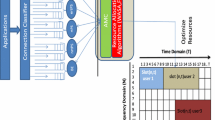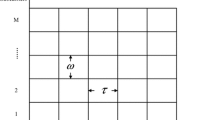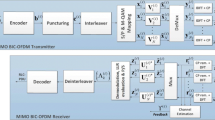Abstract
Cross-layer strategies for resource allocation in wireless networks are essential to guaranty an efficient utilization of the scarce resource. In this paper, we present an efficient radio resource allocation scheme based on PHY/MAC cross layer design and QoS-guaranteed scheduling for multi-user (MU), multi-service (MS), multi-input multi-output (MIMO) concept, orthogonal frequency division multiple access (OFDMA) systems. It is about a downlink multimedia transmission chain in which the available resources as power and bandwidth, are dynamically allocated according to the system parameters. Among these parameters, we can mention the physical link elements such as channel state information, spectral efficiency and error code corrector rate, and MAC link variables, which correspond to the users QoS requirements and the queue status. Primarily, we use a jointly method which parametrizes these system parameters, according to the total power, and the bit error rate constraints. Secondly, we propose a QoS-guaranteed scheduling that shares the sub-carriers to the users. These users request several type of traffic under throughput threshold constraints. The main objective in this work is to adjust the average throughput per service of each user, according to their needs and likewise to satisfy a great number of connexions. Subsequently, we consider a model of moderated compartmentalization between various classes of services by partitioning the total bandwidth into several parts. Each class of service will occupy a part of the bandwidth and will be transmitted over a maximum number of sub-carriers. The simulation results show that the proposed strategy provides a more interesting performance improvement (in terms of average data rate and user satisfaction) than other existing resource allocation schemes, such as nonadaptive resource allocation strategy. The performances are also analyzed and compared for the two multi-service multi-user MIMO–OFDMA systems; with sub-carriers partitioning and without sub-carriers partitioning.














Similar content being viewed by others
References
Abot, J., Olivier, C., Perrine, C., & Pousset, Y. (2012). A link adaptation scheme optimized for wireless jpeg 2000 transmission over realistic MIMO systems. Signal Processing: Image Communication, 27(10), 1066–1078.
Abot, J., Perrine, C., Pousset, Y., & Olivier, C. (2013). An unequal power allocation designed for MIMO systems using content characteristics. International Journal of research and Reviews in Applied Sciences, 16(1), 16.
Afif, M., Sohtsinda, H., Perrine, C., Pousset, Y., & Olivier, C. (2013). A novel cross layer policy based priority management for radio resource allocation in 4G MIMO–OFDMA system (IEEE 802.16m), Trento, Italia. In IEEE Global Information Infrastructure Symposium (pp. 1–3).
Ahmadi, S. (2010). Mobile WiMAX: A systems approach to understanding IEEE 802.16 m radio access technology. London: Academic Press.
Ben Hassen, W., & Afif, M. (2012). A gain-computation enhancements resource allocation for heterogeneous service flows in IEEE 802.16 m mobile networks. International Journal of Digital Multimedia Broadcasting, 2012, 1–13.
Bocquet, W., Hayashi, K., & Sakai, H. (2006). A power allocation scheme for MIMO–OFDM systems. IEEE international symposium on communications, control and signal processing (ISCSSP), Marrakech, Marocco.
Busche, H., Vanaev, A., & Rohling, H. (2009). Svd-based MIMO precoding and equalization schemes for realistic channel knowledge: Design criteria and performance evaluation. Wireless Personal Communications, 48(3), 347–359.
Chan, P. W., & Cheng, R. S.: Reduced-complexity power allocation in zeroforcing MIMO–OFDM downlink system with multiuser diversity. In International symposium on information theory (pp. 2320–2324), IEEE.
Chen, G., Wu, X., Zhang, W., & Zheng, X. (2011). A cross-layer resource allocation algorithm with dynamic buffer allocation mechanism. Journal of Networks, 6(1), 104–111.
Collin, L., Berder, O., Rostaing, P., & Burel, G. (2004). Optimal minimum distance-based precoder for MIMO spatial multiplexing systems. IEEE Transactions on Signal Processing, 52(3), 617–627.
C.R1002-0, G.C. (2004). cdma2000 evaluation methodology, v1.0.
Dahlman, E., Parkvall, S., & Skold, J. (2011). 4G: LTE/LTE-advanced for mobile broadband: LTE/LTE-advanced for mobile broadband. London: Academic press.
Guan, Zj, Li, H., Xu, C. Q., Zhou, Xl, & Zhang, W. J. (2009). Adaptive subcarrier allocation for MIMO–OFDMA wireless systems using hungarian method. Journal of Shanghai University, 13, 146–149.
Habib, A., Baamrani, K. E., & Ouahman, A. (2011). A low-complexity power and bit allocation algorithm for multiuser MIMO–OFDM systems. International Journal of Computer Science Issues (IJCSI), 8(3), 596.
Hassan, N. U., & Assaad, M. (2009). Low complexity margin adaptive resource allocation in down-link MIMO–OFDMA system. IEEE Transactions on Wireless Communications, 8(7), 3365–3371.
Ho, W., & Liang, Y. C. (2009). Optimal resource allocation for multiuser MIMO–OFDM systems with user rate constraints. IEEE Transactions on Vehicular Technology, 58(3), 1190–1203.
Jiang, M., & Hanzo, L. (2007). Multiuser MIMO–OFDM for next-generation wireless systems. Proceedings of the IEEE, 95(7), 1430–1469.
Kambou, S., Perrine, C., Pousset, Y., Olivier, C., & Mhamdi, M. (2014). Low-Complexity and optimal resource allocation scheme for scalable video transmission over realistic noisy MIMO channels. In: IEEE international conference on communication systems (ICCS), Macau, China (pp. 574–578).
Li, Q., Li, G., Lee, W., il Lee, M., Mazzarese, D., Clerckx, B., et al. (2010). MIMO techniques in WiMAX and LTE: A feature overview. IEEE Communications Magazine, 48(5), 86–92.
Lim, C., Yoo, T., Clerckx, B., Lee, B., & Shim, B. (2013). Recent trend of multiuser MIMO in LTE-advanced. IEEE Communications Magazine, 51(3), 127–135.
Lin, K. H., Mahmoud, S.S., & Hussain, Z. M. (2005). Adaptive modulation with space-time block coding for MIMO–OFDM systems. In IEEE international conference on information technology and applications (ICITA) (vol. 2, pp. 299–304), Sydney, Australia.
Liu, L., Chen, R., Geirhofer, S., Sayana, K., Shi, Z., & Zhou, Y. (2012). Downlink MIMO in LTE-advanced: SU-MIMO vs. MU-MIMO. IEEE Communications Magazine, 50(2), 140–147.
Moretti, M., & Perez-Neira, A. I. (2013). Efficient margin adaptive scheduling for MIMO–OFDMA systems. IEEE Transactions on Wireless Communications, 12(1), 278–287.
Moretti, M., Sanguinetti, L., & Wang, X. (2015). Resource allocation for power minimization in the downlink of thp-based spatial multiplexing MIMO–OFDMA systems. IEEE Transactions on Vehicular Technology, 64(1), 405–411.
Nikolaros, I., Zarakovitis, C., Skordoulis, D., Hadjinicolaou, M., & Ni, Q. (2010). Cross-layer design for multiuser OFDMA systems with cooperative game and MMPP queuing considerations. In IEEE 10th international conference on computer and information technology (CIT) (pp. 2649–2654), Bradford, UK.
Odhah, N. A., Hassan, E. S., Abdelnaby, M., Al-Hanafy, W. E., Dessouky, M. I., Alshebeili, S. A., et al. (2015). Adaptive resource allocation algorithms for multi-user MIMO–OFDM systems. Wireless Personal Communications, 80(1), 51–69.
Patteti, K., Kishan, R., & Anil, K. (2013). Novel study of scheduling strategies for multi-user MIMO–OFDM systems with limited feedback. International Journal of Research in Computer and Communication Technology (IJRCCT), 2(10), 936–942.
Prasad, S., Shukla, C., & Chisab, R. (2012). Performance analysis of ofdma in lte. In: Third international conference on computing communication networking technologies (ICCCNT) (pp. 1–7), Tamilnadu, India.
Sann Maw, M., & Sasase, I. (2008). Resource allocation scheme in MIMO–OFDMA system for user’s different data throughput requirements. IEICE Transactions on Communications, 91(2), 494–504.
Sharma, V., & Lambotharan, S. (2006). Robust multiuser beamformers in MIMO–OFDM systems. In IEEE international conference on communication systems (pp. 1–5), Singapore.
Srikanth, S., Pandian, M., & Fernando, X. (2012). Orthogonal frequency division multiple access in wimax and lte: A comparison. IEEE Communications Magazine, 50(9), 153–161.
Sun, Q., Tian, H., Wang, S., Dong, K., & Zhang, P. (2009). Novel resource allocation algorithms for multiuser downlink MIMO–OFDM of FuTURE B3G systems. Progress in Natural Science, 19(9), 1141–1146.
Tarokh, V., Naguib, A., Seshadri, N., & Calderbank, A. R. (1999). Space-time codes for high data rate wireless communication: Performance criteria in the presence of channel estimation errors, mobility, and multiple paths. IEEE Transactions on Communications, 47(2), 199–207.
Xia, P., Zhou, S., & Giannakis, G. B. (2004). Adaptive MIMO–OFDM based on partial channel state information. IEEE Transactions on Signal Processing, 52(1), 202–213.
Xiao, S., Xiao, X., Li, B., & Hu, Z. (2005). Adaptive subcarrier allocation for multiuser MIMO–OFDM systems in frequency selective fading channel. In IEEE—International conference on wireless communications, networking and mobile computing (WiCOM) (vol. 1, pp. 61–64), Wuhan, China.
Yang, F., Zhang, Q., Zhu, W., & Zhang, Y. Q. (2001). An efficient transport scheme for multimedia over wireless internet. In Proceedings of the international conference on third generation wireless and beyond, CA, USA.
Zhao, J., Guan, X., LI, X., & Zeng, L. (2014). Cross-layer in MIMO–OFDM system with adaptive modulation and coding: Design and analysis. Chinese Journal of Electronics, 23(2), 371–376.
Zhu, X., & Murch, R. (2002). Performance analysis of maximum likelihood detection in a MIMO antenna system. IEEE Transactions on Communications, 50(2), 187–191.
Author information
Authors and Affiliations
Corresponding author
Rights and permissions
About this article
Cite this article
Kambou, S., Perrine, C., Afif, M. et al. Resource allocation based on cross-layer QoS-guaranteed scheduling for multi-service multi-user MIMO–OFDMA systems. Wireless Netw 23, 859–880 (2017). https://doi.org/10.1007/s11276-015-1183-x
Published:
Issue Date:
DOI: https://doi.org/10.1007/s11276-015-1183-x




